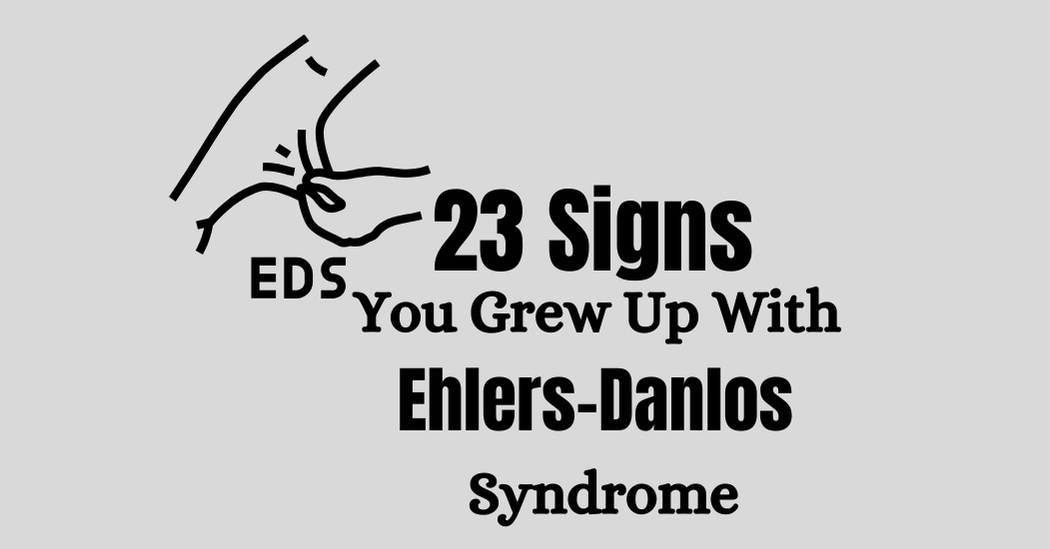23 Signs You Grew Up with Ehlers-Danlos Syndrome (EDS)

Ehlers-Danlos Syndrome (EDS) is a group of genetic disorders that primarily affect connective tissues. These tissues, which include skin, joints, and blood vessel walls, are crucial for providing strength and elasticity to the body. Living with EDS can present numerous challenges, especially for those who grew up with the condition without a proper diagnosis. In this article, we outline 23 Signs You Grew Up with Ehlers-Danlos Syndrome (EDS), shedding light on the condition and helping you better understand your experiences.
What Are 23 Signs You Grew Up with Ehlers-Danlos Syndrome (EDS)?
Here Are the 23 Signs You Grew Up with Ehlers-Danlos Syndrome (EDS). Read about them to have a better idea about this condition.
1. Hypermobility of Joints
One of the hallmark signs of EDS is joint hypermobility, where your joints move beyond the typical range of motion. Being “double-jointed” might have seemed like a fun party trick, but it often came with joint pain and instability.
2. Frequent Joint Dislocations
Did you experience frequent dislocations, particularly in your shoulders, knees, or elbows? This is a common occurrence in individuals with EDS, as the connective tissue lacks the strength to keep joints stable.
3. Chronic Pain
3rd in 23 Signs You Grew Up with Ehlers-Danlos Syndrome is Persistent musculoskeletal pain that’s often misdiagnosed as fibromyalgia or growing pains is another telltale sign of EDS.
4. Stretchy Skin
People with EDS often have skin that stretches more than usual. While this can appear fascinating, it is usually a sign of weakened connective tissue.
5. Easy Bruising
If you’ve always bruised easily from minor bumps or scratches, this might be due to the fragile skin associated with EDS.
6. Delayed Developmental Milestones
Children with EDS may take longer to reach physical developmental milestones, such as walking, due to muscle weakness and joint instability.
7. Frequent Subluxations
Partial joint dislocations, also known as subluxations, can happen regularly, causing pain and instability.
8. Muscle Weakness
Many individuals with EDS experience general muscle weakness, which can impact their ability to participate in physical activities.
9. Clumsiness
Difficulty with coordination often leads to frequent falls or tripping, especially during childhood.
10. Chronic Headaches
Frequent headaches, often linked to muscle tension or neck instability, are common among people with EDS.
11. Poor Posture
Maintaining good posture can be a challenge due to joint hypermobility and muscle weakness.
12. Difficulty with Physical Activities
Engaging in sports or physical activities may have been tough due to joint instability and chronic pain.
13. Sensory Processing Issues
Sensitivity to touch, sound, or light is prevalent among some individuals with EDS, making everyday experiences overwhelming.
14. Anxiety and Depression
Living with chronic pain and a misunderstood condition can lead to mental health challenges, including anxiety and depression.
15. Fatigue
Chronic fatigue, even after adequate rest, is a common complaint among those with EDS.
16. Dizziness upon Standing
Experiencing dizziness or fainting when standing quickly may occur due to related conditions like Postural Orthostatic Tachycardia Syndrome (POTS).
17. Increased Flexibility in Fingers and Toes
Unusual flexibility in your fingers and toes is another sign of joint hypermobility.
18. Frequent Gastrointestinal Problems
Digestive issues, such as constipation, irritable bowel syndrome (IBS), or delayed gastric emptying, are common in people with EDS.
19. Feeling Different from Peers
Many individuals with EDS report feeling isolated or different due to their physical limitations and chronic symptoms.
20. Frequent Foot Problems
Pain and discomfort in the feet, often caused by flat arches or joint instability, can be a frequent issue.
21. Difficulty Sleeping
Chronic pain, discomfort, and anxiety can disrupt sleep patterns, leading to insomnia.
22. Increased Risk of Fractures
More frequent bone fractures may occur due to joint instability and fragile connective tissues.
23. Cognitive Impairments
Last in 23 Signs You Grew Up with Ehlers-Danlos Syndrome is Difficulties with memory, concentration, and focus, often referred to as “fibro fog,” are reported by many individuals with EDS.
Amir Jaberzadeh Elucid Remarkable Journey in AI & Healthcare
Understanding Life with EDS
Growing up with EDS can be challenging, particularly if the condition goes undiagnosed. The combination of physical pain, emotional struggles, and a lack of understanding from others can take a toll. However, recognizing these signs and seeking a diagnosis is the first step toward managing the condition and improving your quality of life. The 23 Signs You Grew Up with Ehlers-Danlos Syndrome (EDS) given above have been written for this purpose.
Coping Mechanisms and Management Strategies
- Physical Therapy: Strengthening muscles around the joints can improve stability and reduce pain.
- Pain Management: Work with healthcare professionals to develop a pain management plan, which may include medication or alternative therapies.
- Lifestyle Modifications: Avoid activities that strain your joints and focus on low-impact exercises like swimming.
- Emotional Support: Joining support groups or seeking therapy can help you cope with the mental health challenges associated with EDS.
- Medical Monitoring: Regular check-ups with specialists can help manage symptoms and prevent complications.
Conclusion
Ehlers-Danlos Syndrome is a complex condition that affects every aspect of life. Recognizing the 23 Signs you grew up with Ehlers-Danlos Syndrome (EDS) is crucial for understanding the challenges you’ve faced and taking steps to manage your health. While living with EDS can be difficult, proper diagnosis, medical care, and support can significantly improve your quality of life. This blog recounted the 23 signs you grew up with Ehlers-Danlos Syndrome (EDS).
For More updates: Click Here!
FAQs
What is Ehlers-Danlos Syndrome (EDS)?
EDS is a group of genetic disorders that affect connective tissues, leading to symptoms like joint hypermobility, stretchy skin, and chronic pain.
How is EDS diagnosed?
23 Signs You Grew Up with Ehlers-Danlos Syndrome EDS is diagnosed through a combination of medical history, physical examination, and, in some cases, genetic testing.
Is there a cure for EDS?
There is no cure for EDS, but symptoms can be managed through physical therapy, medication, and lifestyle modifications.
Can EDS symptoms worsen over time?
Yes, EDS symptoms can worsen with age, particularly if joints and tissues are not properly cared for. All 23 signs you grew up with Ehlers-Danlos Syndrome (EDS) are provided in the above blog.
How can I support someone with EDS?
Offer understanding, patience, and emotional support. Educate yourself about the condition to better empathize with their experiences. All 23 signs you grew up with Ehlers-Danlos Syndrome (EDS) are provided in the above blog.






